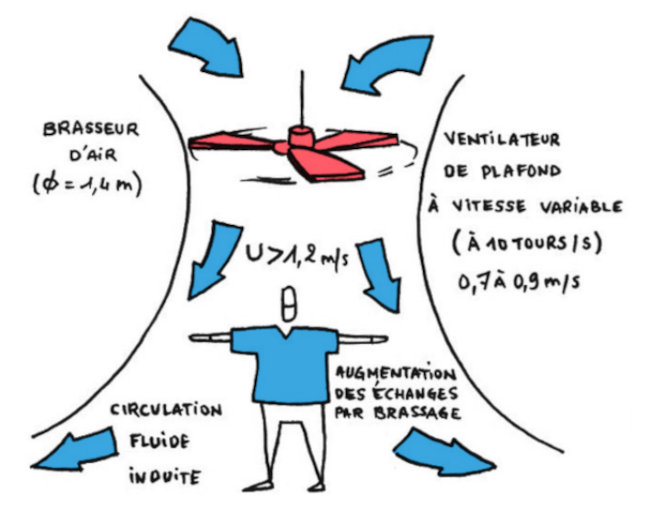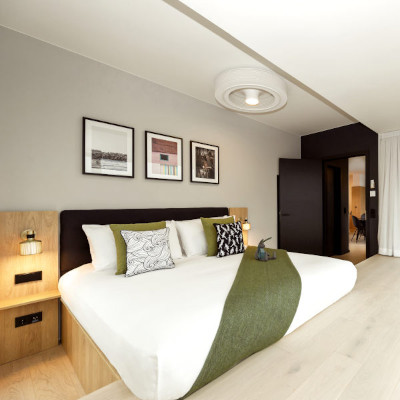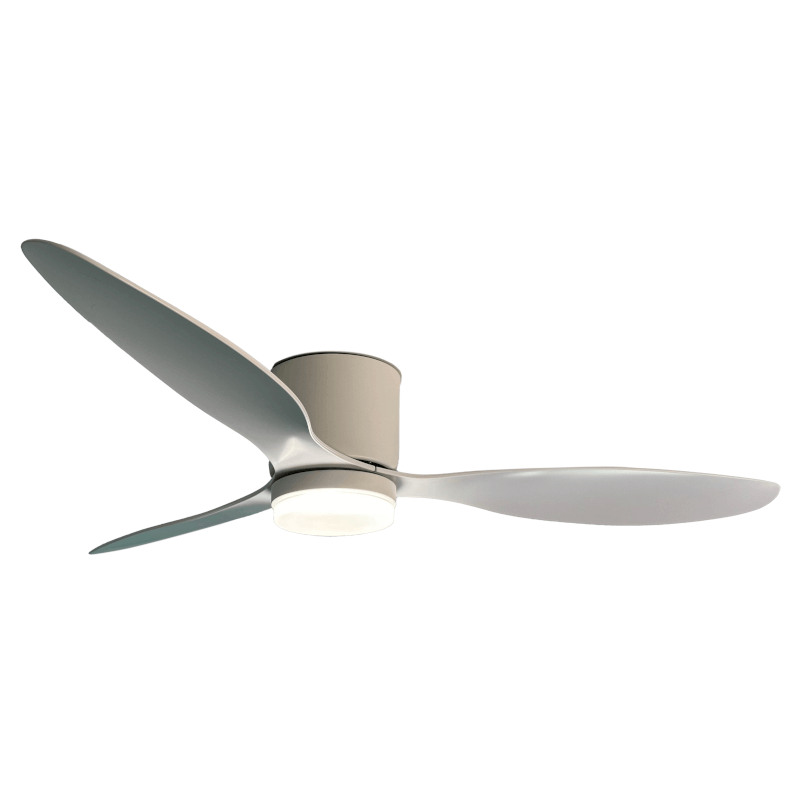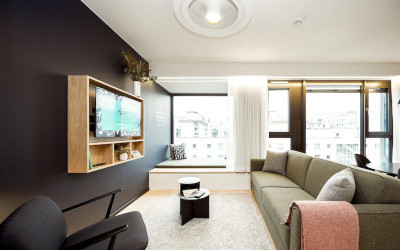Ceiling fans for RE2020
Whatever your project, one of our ceiling fans will meet your requirements. New or old homes, construction, equipment, redevelopment…
What is your project?
Ceiling fans are a very simple way of drastically reducing discomfort in summer and between seasons.
Residential

Tertiary

Find out more about RE2020 and ceiling fans


What is your project?
Ceiling fans are a very simple way of drastically reducing discomfort in summer and between seasons.
Residential

Tertiary

Find out more about RE2020 and ceiling fans

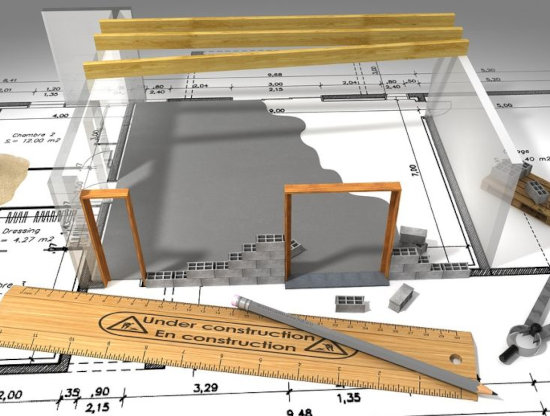
Download the ceiling fan sizing and installation guide

Download our guide to bladed ceiling fans

Basic information on the RE2020

RE2020 : What is the 2020 Environmental Regulation?
Lire la suite

Summer comfort and RE2020 :
What's new?
Lire la suite

Why are ceiling fans so important in RE2020?
Lire la suite

Lire la suite

Lire la suite

Lire la suite

Lire la suite

Lire la suite

Lire la suite
Our solutions for the Residential and Commercial sectors

Our selection of RE2020 ceiling fans
Exhale and Samarat ceiling fans are innovative, cost-effective choices for professionals looking to improve air circulation in their commercial or service premises. Our ceiling fans, with their unique, patented technology, offer an efficient alternative to conventional air-conditioning systems.
RE2020-compliant ceiling fans
With the RE2020, ‘Ceiling fans will become the benchmark for limiting discomfort in summer’. (Pouget Consultants & Bastide Bondoux & Tribu report).
Ceiling fans are highly valued for their effect on Degree Hours. It is even superior to that of the air handling unit in zone H3…
These are extracts from the report (available in our pro section) produced jointly by Bastide Bondoux, Pouget Consultants and Tribu Energie (Sensitivity study on the RE 2020 regulatory calculation engine), updated on 16 July 2021.
This report shows the extent to which deciphering the part of the RE2020 devoted to ceiling fans is fundamental to preparing for this revolution.
Ceiling fans save energy and resources. They are easy to install and, depending on the model, can be adapted to suit all room and ceiling configurations.
If the maximum Degrees Hours threshold of 1250 DH (1250 Degrees Hours) is used to define a non-regulatory building, the addition of ceiling fans in zone H3 H2D will make the building regulatory.
The effect of ceiling fans on DH is still highly valued. Ceiling fans appear to be a very simple way of drastically reducing discomfort, particularly in H3 H2D zones, and are even superior to air handling units in H3 zones…
Today, in non-through multi-family dwellings in zone H3 or H2D, it is virtually impossible to fall below the RE2020 regulatory threshold of 1250 Degrees Hours without installing ceiling fans.
If the DH max threshold of 1250 DH is used to define a non-regulatory building, the addition of fans in zone H3 will make the building regulatory. Ceiling fans will become the benchmark for limiting discomfort in summer. The ceiling fan essentially acts on the operating temperature (perceived comfort) by increasing the air speed. It therefore has no effect on cooling requirements, unlike other passive means such as automatic management of movable protection and opening of windows.


➔ For this variant the BET integrated 4 ceiling fans (1 living room + 3 bedrooms) – We recommend that the whole dwelling be equipped with ceiling fans to guarantee summer comfort, with this technology. The action of a fan is limited only to the room in which it is located, it is hardly acceptable to reduce the summer discomfort of the whole building with a single ceiling fan.
What’s more, unlike air conditioning, which heats the outside to cool the inside, a ceiling fan has no external impact.
It consumes very few resources (at least twenty times less than air conditioning) and is simple to install while remaining affordable.
Experts in ceiling fans
Our experts answer your questions. Installation for new or old homes, apartment blocks or detached houses, residential sectors, schools or commercial buildings… We’ve got the solution!
Our EXHALE SAMARAT and IZYFANS ceiling fans are popular in many public and private establishments.
They are used in education (schools, colleges, universities), offices and public buildings (CPAM Primary health insurance fund, town halls) and collective housing (CROUS, EHPAD).
The improved thermal comfort experienced by users all year round, the ease of installation and the low running costs mean that concrete results can be achieved quickly in a wide range of configurations.
The fans provide a clear reduction in summer discomfort for pupils, residents, employees and users, at a controlled installation and running cost.

CPAM Annecy (Primary health insurance fund)

Mistral primary schools

Proteion retirement home
Ultra-flat ceiling fans
Our Exhale fans, which have no blades, and Samarat fans, which are thin, meet safety requirements while fitting all ceilings, including the lowest (2m50).
For the first, the absence of blades eliminates any risk of injury. It is therefore particularly popular in schools and public buildings.
With ultra-flush fans, it’s easier to comply with safety standards, which specify a minimum height between the floor and the blades of 2.30 metres. On ceilings of 2.50 m, it is virtually impossible to install non-flush fans, as they are often more than 25 cm high. Only monobloc or flush-mounted fans can be less than 20 cm thick (Exhale is 16.5 cm under the blades and Samarat is 17 cm (model without LEDs) and 18 cm (model with LEDs).
Ceiling fans in MaPrimeRénov’2024
The inclusion of ceiling fans in the 2024 version of Ma Prime Renov’ in France is a real step forward for the renovation of buildings for all households, whatever their circumstances. Ceiling fans (also known as ceiling ventilators) are an economical and easy-to-install solution (without affecting the building) for improving the thermal comfort of occupants all year round.
Whether you’re looking for winter (or autumn) comfort through destratification, or summer comfort through the generation of a cooling breeze, ceiling fans will add a real plus to your renovation at a fraction of the cost.
The tax incentive can be as much as 90% of the cost of the work (see press kit from the French Ministry for Ecological Transition on how MaPrimeRénov’2024 works).
Join our Professional Area
Section for Professionals
Design offices, architects, installers, dealers… we’ve designed a professional area for you with a wealth of free resources to help you integrate ceiling fans (HVLS, with blades, without blades) into your projects.
You’ll find :
- Short guides on specific topics to help you master professional ceiling fans.
- Information on the RE2020 and its calculation engines, as well as input help sheets.
- Standard clauses for your SCCs.
- Technical information (installation, instructions, layout, etc.).
- Resources on air circulation and destratification (summer and winter comfort).
- And much more….
Our experienced technical teams will be happy to provide you with any further information you may require.
Our references in France
Our customers
Crèches, schools, secondary schools, universities
Town halls, administrative buildings, ERP
Ministry of Defence
CROUS, EHPAD, CPAM
Prisons, airports
Hotels, restaurants
Collective housing
Individual homes
Sports halls
Offices
The benefits of ceiling fans for professionals
Improved air circulation
Our Samarat and Palehe ceiling fans create cyclonic air movement, eliminating dead zones of stagnant air. This significantly improves air quality and temperature distribution in professional spaces such as offices, warehouses, shops or restaurants.

Our Exhale ceiling fans do not use blades to move the air. Instead, they are equipped with a ventilation system that creates a circular airflow by drawing in air from below and propelling it over the walls, creating an even airflow throughout the room. Not only is this technology more efficient than traditional fans, it is also safer, as there are no moving blades.
Energy saving
The Exhale ceiling fan consumes up to 50% less energy than traditional AC ceiling fans. By optimising air circulation, professionals can save money on their heating and air-conditioning bills by reducing their use.
Greater comfort for employees and customers
A comfortable environment is essential to ensure the satisfaction and productivity of employees and the well-being of customers. Our ceiling fans help maintain a pleasant, uniform temperature in commercial premises, without causing unpleasant draughts or major temperature fluctuations.
Discreet, silent design
With its sleek, blade-less design, the Exhale fan blends harmoniously into any professional environment. Thanks to its blade-less design, our fans are extremely quiet, which is particularly important in workspaces where noise can be a source of distraction or stress.

How do you choose the right ceiling fan for your professional space?
Room size and fan power
It is important to take into account the size of the room where the ceiling fan is to be installed in order to choose a suitable model. The fan’s power must be sufficient to cover the entire space, otherwise the efficiency of air circulation will be compromised. Sometimes several fans are needed in the same room, depending on the parameters (orientation, size of the room, ceiling height, temperature reduction target, etc.). Our teams of experts can help you to plan (densify) the number of fans as accurately as possible, so don’t hesitate to contact us.
Ceiling type
Our Exhale & Samarat fans come with accessories that allow them to be installed on flat or sloping ceilings. If your professional space has a sloping ceiling, make sure you select our extendable & tiltable rod accessory.
Control options
Our Exhale, Samarat and Palehe ceiling fans are available with different control options, such as wired or wireless wall remotes. Depending on your preferences and needs, choose a model with the control options that suit you best.
Wall-mounted (battery powered / 220 volts)
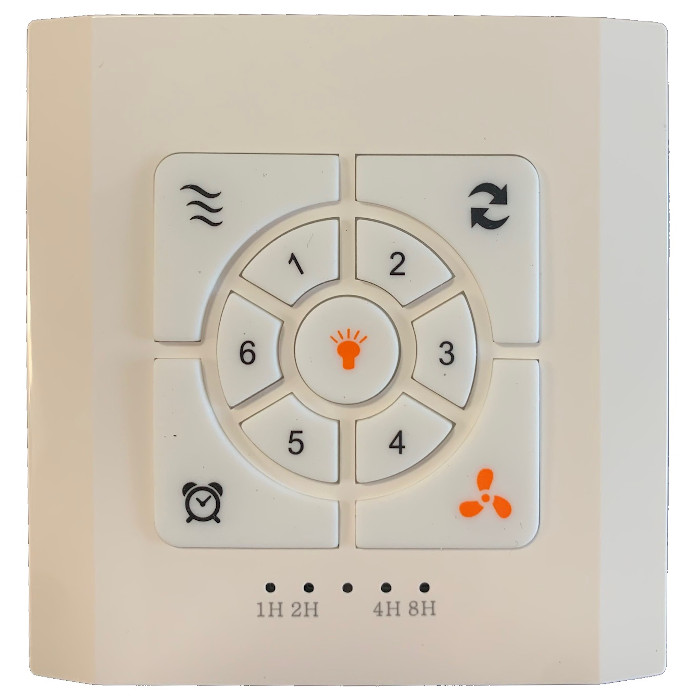
Wall-mounted (220v)
With timer

5-position stem (plenum)
3 extensible rod lengths 30-40 (tilting) / 40-60 / 60-90 cm

Design and style
Depending on the style and layout of your professional space, it may be important to choose a ceiling fan whose design blends harmoniously with your decor. Our Exhale and Samarat models will easily match your environment.

Installing and maintaining the ceiling fan
Professional installation recommended
We strongly recommend that you use a qualified professional to install your Exhale, Samarat or Palehe ceiling fan. This not only ensures correct and safe installation, but also optimum fan performance.
Regular maintenance
To maintain the efficiency and durability of your ceiling fan, regular maintenance is necessary. This includes cleaning the fan and checking the mechanical components to make sure they are working properly. For example, our Exhale fan is very easy to maintain. The main maintenance will be an annual dusting of the fans using cotton gloves and a cloth soaked in soapy water. Our Exhale fan has no consumables (wearing parts) to change. Please refer to the user manual supplied with our fans for specific maintenance instructions.
Articles and news
CPAM of Haute-Savoie in France: the winning combination of energy efficiency and summer comfort
Three years later, after a lot of hard work, the results are in: 36% annual energy savings for the Annecy site, and first place in the Cube 2023 competition for offices over 5,000 m²!
Summer comfort in educational establishments: ceiling fans to the rescue?
With hot spells sometimes starting in May and ending in September, educational establishments are increasingly confronted with thermal discomfort that degrades learning conditions. What solutions are becoming possible to improve the situation in existing buildings?
Advantages of ceiling fans – Extracts from the BRISE report
The benefits of using a ceiling fan rather than air conditioning – Extract from the BRISE report (page 24)
“At the same temperature, a ventilated home will be much more comfortable, because the air movements create a feeling of freshness. As an inexpensive piece of equipment, a fan creates conditions of comfort at a lower overall cost (investment/operation/environment/company) in a tropical climate, given that it consumes at least 10 times less energy (and possibly up to 40 times less) than an air conditioner for the same level of comfort.
Ceiling fans also help to overcome some of the comfort limitations of natural ventilation, which requires you to keep your windows open and be exposed to noise and air pollution.
In the intermediate season, the fan will create mechanical ventilation that can provide comfort with the windows closed, while preserving the acoustic privacy of the user, particularly in a bedroom. Ceiling fans provide undeniable comfort in both air-conditioned and non-air-conditioned spaces.
8 Advantages of ceiling fans – Extract from the breeze report (page 25)
1. Ceiling fans are an alternative to air conditioning
Ceiling fans are a sustainable solution on all fronts, and could become a total alternative to air conditioning in certain spaces (living rooms, bedrooms, classrooms, etc.) or only partial in others (offices, public buildings, etc.). In addition to the gains in thermal comfort, fans help to improve other aspects of overall user comfort. For example, the air flow created effectively combats mosquitoes. What’s more, unlike air conditioners, they do not contain refrigerants (a component of air conditioning), the leakage of which makes a significant contribution to global warming.
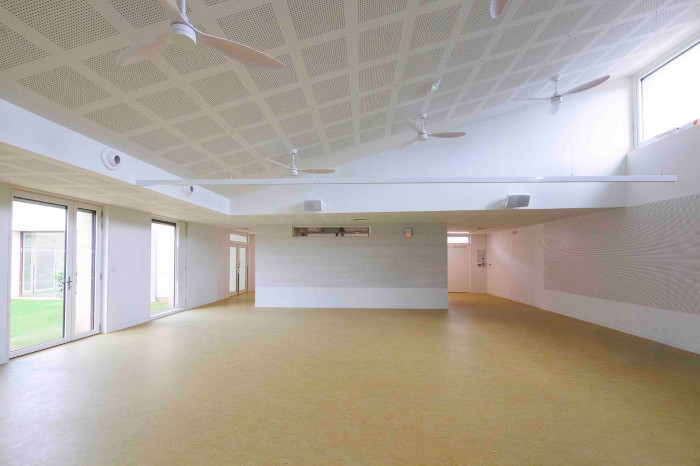
Izyfan – Castillon du Gard school group

Samarat – Castillon du Gard school group
2. Ceiling fans improve hygiene ventilation (indoor CO2 levels)
Improved hygiene ventilation (indoor CO2 level) As a total or partial alternative to air conditioning: operating with the windows open means that rooms do not have to be ventilated from time to time. On the other hand, closed air-conditioned rooms must provide hygiene ventilation with air renewal (fresh air supply of 18 m3 /h/person). Failure to do so will result in regulatory non-compliance. The problem is widespread in the French overseas territories, in both residential and commercial buildings. The consequences for public health are significant: in air-conditioned rooms without hygiene ventilation, CO2 levels can rise to over 1000 ppm.
3. Ceiling fans extend the life of air conditioners
Unlike heating in temperate zones, air conditioning is used intermittently, depending on the function of the building: during the day in commercial buildings, and at night in residential buildings, with up to 3,000 hours of use per year in each case. Switching off air conditioning in the cooler and shoulder seasons can reduce the number of hours per year that air conditioning is used, thereby reducing wear and tear on the equipment and increasing its lifespan.
4. Fans can be combined with air conditioners, optimising their sizing.
Ceiling fans can also be used in conjunction with air conditioning. In this way, the set air-conditioning temperatures can be increased by several degrees (editor’s note: this represents significant energy savings – around 7 to 10% per 1 degree increase in set temperature). This practice makes it unnecessary to oversize air-conditioning equipment, which, if need be, is detrimental to energy efficiency. In this case, the air-conditioning unit can be considered as a back-up to provide thermal comfort for the user in boundary conditions and dehumidify in the hot, humid season, within operating ranges of 26 to 28°C.
5. Reducing health risks by limiting thermal shocks (outdoor/indoor environments)
This sober and efficient method of operation also makes it possible to create gentle environments where the interfaces between indoors and outdoors are managed without thermal shock. For the most part, tropical climatic conditions mean that temperature differences between indoors and outdoors can be limited to around 5 degrees, i.e. an indoor temperature of 25°C for an outdoor temperature of 30°C. By raising the set point to 27°C when it’s 32°C outside, the fan keeps the difference within 5 degrees. This is particularly useful in the reception areas of air-conditioned commercial premises.
6. Reducing mould and condensation problems in air-conditioned spaces
In coupled operation, increasing the set temperature of the air conditioning ensures that it no longer generates problems of mould or condensation in the rooms! As a reminder, these problems are generated by air-conditioned spaces below the dew point temperature, which is around 20-22°C in the West Indies, for example.
7. Ceiling fans do not produce refrigerants that are harmful to the environment.
Refrigerators and air conditioners use harmful refrigerants that often end up in the atmosphere as a result of leaks or when old installations are dismantled. Air blowers do not use any refrigerants.
8. Ceiling fans protect against mosquitoes
Mosquitoes don’t fly into the fan cone! So occupants are protected. Feedback from users shows that this is a real advantage in all seasons and in all areas treated.
9. Ceiling fans avoid cooling the whole room just to cool a few people (p32)
Using energy to cool down in summer is a relatively recent phenomenon.
Before the advent of air conditioning in the first half of the twentieth century, buildings in hot climates were designed to be naturally ventilated, protected from the sun’s rays, and the inhabitants adapted to the heat by changing their habits.
Cooling with air conditioning means refrigerating all the air in an enclosed space. The larger the space and the fewer the occupants, the more energy is needed to cool each person.
Ceiling fans, like natural ventilation, give us a feeling of freshness by stimulating the skin’s natural heat dissipation process, thanks to the speed of the air on the skin.
Circulating air requires much less energy than refrigerating it.
How ceiling fans work & Physiology – Extracts from the BRISE report
How a ceiling fan works from a physiological point of view – Extract from the BRISE report (pages 39 & 40)
In hot weather, the (human) body has to evacuate the heat it produces to maintain an internal temperature of close to 37°C, mainly through the skin.
The intelligence of ceiling fans (and other natural or mechanical ventilation devices) is to stimulate the natural function of heat evacuation at skin level, i.e. the body’s main internal and external heat exchange zone as a thermal machine. Cooling systems, on the other hand, instead of stimulating this epidermal and dermal heat exchange (atchoum), ‘stupidly’ (i.e. very inefficiently from an energy point of view) cool the whole room so that it in turn cools the body.
The role of a ceiling fan is to increase this air speed in order to generalise this acceleration of thermal evacuation, enabling the human body to remain at 37°C. This speed will be distributed fairly evenly over the body, as the downward blast will envelop almost the entire surface of the body in a fairly uniform flow.
The occupant should then be able to adjust the speed of the fan to literally ‘adjust’ this exchange according to the temperature and humidity conditions in the room and his or her ‘personal’ parameters: clothing and metabolism.
Ventilation principle using a ceiling fan. Diagram taken from the BRISE Guide, page 40.
